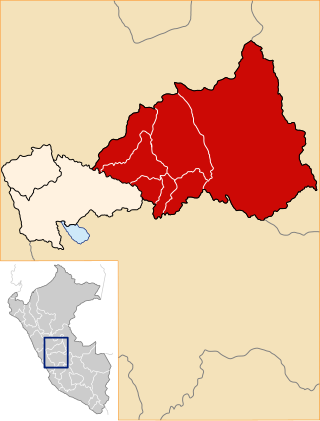
Huánuco is a department and region in central Peru. It is bordered by the La Libertad, San Martín, Loreto and Ucayali regions in the north, the Ucayali Region in the east, the Pasco Region in the south and the Lima and Ancash regions in the west. Its capital is the city Huánuco.

Mountain coatis are two species of procyonid mammals from the genus Nasuella. Unlike the larger coatis from the genus Nasua, mountain coatis only weigh 1.0–1.5 kilograms (2.2–3.3 lb) and are endemic to the north Andean highlands in South America.

The western mountain coati or western dwarf coati is a small procyonid, found in cloud forest and páramo at altitudes of 1,300–4,250 metres (4,270–13,940 ft) in the Andes of Colombia and Ecuador. A population discovered in the Apurímac–Cuzco region of southern Peru has tentatively been identified as the western mountain coati, but may represent an undescribed taxon.

The Oxapampa Province is the largest of three provinces that make up the Pasco Region in Peru. The capital of the Oxapampa province is the city of Oxapampa. The province is located on the eastern slopes of the Andes reaching down to the lowlands of the Amazon Basin. The high point of the province is approximately 5,300 metres (17,400 ft) in elevation near the summit of Huaguruncho mountain in the Huancabamba District and the low point is approximately 200 metres (660 ft) on the Pachitea River in the Constitución District.
Atelopus siranus is a species of toad in the family Bufonidae.
Hyloxalus patitae is a species of frogs in the family Dendrobatidae. It is endemic to Peru where it is only known from its type locality near Comunidad Nativa de Davis, Cordillera El Sira, Pasco Region.
Callimedusa baltea is a species of frog in the subfamily Phyllomedusinae. It is endemic to the western slope of the Serrania de Sira, Department of Huánuco, Peru. Common name purple-sided leaf frog has been proposed for it. The specific name baltea is Latin for "border" and refers to the salmon line that separates the dorsal and ventral colors of this frog.

The scarlet-banded barbet is a species of bird in the New World barbet family, Capitonidae. It is endemic to Peru.
Kosñipata District is one of six districts of the province Paucartambo in Peru.
El Sira Communal Reserve is a protected area in Peru created to preserve the biodiversity of the Sira Mountains and the ancestral sustainable use of the area's resources by the nearby native peoples. It also protects the headwaters of the Pachitea river basin. The reserve covers an area of 616,413 hectares (6,164.13 km2) within the regions of Huánuco, Pasco and Ucayali. The reserve was created in 2001 and in 2010, UNESCO recognized it as part of the Oxapampa-Asháninka-Yánesha Biosphere Reserve.

The Coiban mastiff bat is a species of bat in the family Molossidae. Its range extends from Chiapas in southern Mexico to Mato Grosso in Brazil, including Peru, Ecuador, Venezuela, Panama, Costa Rica and El Salvador. The taxonomic status of the populations in Central America is uncertain. The species is insectivorous and is known from a variety of forest habitats at elevations from near sea level to 1300 m.

Ranitomeya sirensis or the Sira poison frog is a species of poison dart frog found in the Amazonian rainforests of northern Bolivia, westernmost Brazil (Acre), and eastern Peru.

The Sira barbet is a bird in the family Capitonidae, the New World barbets. It is endemic to the Cerros del Sira of east-central Peru.

The Sira curassow is a species of bird in the family Cracidae. It is found in the Cerros del Sira in central Peru. Its natural habitat is tropical, moist, montane cloud forest.
Potamites erythrocularis is a species of lizards in the family Gymnophthalmidae. It is endemic to Manu National Park, in the Region of Cusco, Peru.

Potamites is a genus of lizards in the family Gymnophthalmidae. The genus is restricted to northern South America and southern Central America. They are semiaquatic and found near streams.

Potamites ecpleopus, the common stream lizard , is a species of lizard in the family Gymnophthalmidae. It is found in Colombia, Ecuador, Bolivia, Brazil, and Peru.
Potamites juruazensis is a species of lizard in the family Gymnophthalmidae. It is found in western Brazil (Acre) and Peru.

Potamites montanicola is a species of lizard in the family Gymnophthalmidae. It is endemic to Peru.

Potamites strangulatus, the big-scaled neusticurus, is a species of lizard in the family Gymnophthalmidae. It is found in Ecuador and Peru.












